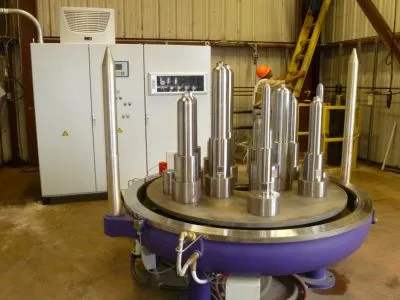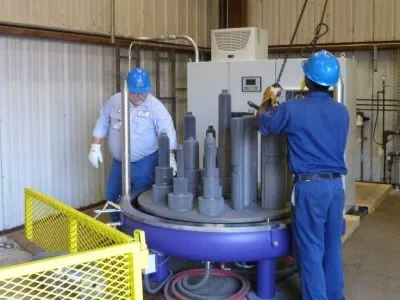Nitriding is a heat-treatment process that diffuses nitrogen inside the steel grade, increasing the surface hardness, wear resistance (both abrasive and adhesive wear), corrosion resistance and improving fatigue life of the tools and parts. But what is the difference between different nitriding methods, and what is the difference between nitriding and carburizing?
Ionitech's Ion/Plasma Nitriding
Ion/Plasma Nitriding process takes place under vacuum. After the vacuum furnace is evacuated, the working gas is introduced. An electrical voltage is applied between the workload (cathode) and the furnace walls (anode). The gas is partially ionized and nitrogen and hydrogen ions start bombarding the surface creating a sputtering effect (atomic cleaning) and also heat up the parts. Formation of the compound layer (white layer) and diffusion of nitrogen start to form when the parts reach the needed temperatures.
Gas Nitriding
The furnace is either a vacuum furnace or an atmospheric furnace. It is filled with the working gases and heated by heaters. The heat dissolves the ammonia gas into nitrogen and hydrogen, creating the needed atmosphere. Nitrogen diffuses into the steel and forms the white layer on top, and the diffusion zone below.
Ion/Plasma Nitriding vs. Gas Nitriding Comparison
Ion/ Plasma Nitriding | Gas Nitriding | |
Process temperature range | 300 – 700 C | 500 – 600 C |
Process time range | from 1 minute up to 100 hours (most often process times: 6 – 12 hours) | 5 to 100 hours |
Process gases | N2; H2; Ar (special cases); NH3*; | N2; H2; NH3; |
Achieved surface hardness | Depending on the steel grade: 400 – 1300 HV | Depending on the steel grade: 400 – 1300 HV |
Compound zone (white layer) | Most often gamma-prime phase (γ’), but can be controlled better to form epsilon-phase (ε) or no white layer. | Typically, consists of a mixture of both epsilon (ε) and gamma prime (γ') phases. Epsilon phase is bigger. |
Diffusion layer | Depending on the steel grade: 0.02 – 0.8 mm | Depending on the steel grade: 0.02 – 0.8 mm |
Possibility for Post Oxidation | yes | yes |
Advantages |
|
|
Disadvantages |
|
|
* Ammonia gas (NH3) can be used in Ion/Plasma nitriding instead of N2 and H2 gases. But unlike in gas nitriding, Ammonia used is 90% less, and it dissociates during the process. Emission in the air is minimal and non-dangerous for the environment and workers. (Measurements done at Ionitech’s facility).
** T. Bell case study.
Salt-Bath Nitriding
The parts are submerged in a cyanide (CN) and cyanate (CNO) salt bath. The working temperature of the process is about 550 – 600 C, and decomposes the salts which release nitrogen and carbon atoms that diffuse into the steel, creating the white layer on top and the diffusion zone below.
Ion/Plasma Nitriding vs. Salt-Bath Nitriding Comparison
Ion/ Plasma Nitriding | Salt-Bath Nitriding | |
Process temperature range | 300 – 700 C | 550 – 600 C |
Process time range | from 1 minute up to 100 hours (most often process times: 6 – 12 hours) | 1 – 4 hours |
Process gases | N2; H2; Ar (special cases); NH3*; | cyanide/cyanate salts |
Achieved surface hardness | Depending on the steel grade: 400 – 1300 HV | Depending on the steel grade: 400 – 1300 HV |
Compound zone (white layer) | Most often gamma-prime phase (γ’), but can be controlled better to form epsilon-phase (ε) or no white layer. | Typically, consists of a mixture of both epsilon (ε) and gamma prime (γ') phases. Almost no control over the formation. |
Diffusion layer | Depending on the steel grade: 0.02 – 0.8 mm | Depending on the steel grade: 0.1 – 0.5 mm |
Possibility for Post Oxidation | yes | yes (separate bath) |
Advantages |
|
|
Disadvantages |
|
* Ammonia gas (NH3) can be used in Ion/Plasma nitriding instead of N2 and H2 gases. But unlike in gas nitriding, Ammonia used is 90% less, and it dissociates during the process. Emission in the air is minimal and non-dangerous for the environment and workers. (Measurements done at Ionitech’s facility).
Carburising
Similar to nitriding, carburizing is a diffusion heat-treatment process, but it diffuses carbon into the steel, instead of nitrogen. The process is performed at high temperatures in the austenitic phase of the steel, and this allows for high hardness and large case depths. A major drawback is that it requires post-process heat treatments to temper the steel because of the phase change – the carburizing process takes place in the temperature zone of the austenite phase. Post-process grinding and machining is needed as well, because the high temperatures lead to distortions of the parts.
Ion/Plasma Nitriding vs. Carburising Comparison
Ion/ Plasma Nitriding | Carburising | |
Process temperature range | 300 – 700 C | 850 – 950 C |
Process time range | from 1 minute up to 100 hours (most often process times: 6 – 12 hours) | 4 - 10 hours |
Process gases | N2; H2; Ar (special cases); NH3*; | CO, CH4; |
Achieved surface hardness | Depending on the steel grade: 400 – 1300 HV | 750 - 850 HV |
Compound zone (white layer) | Most often gamma-prime phase (γ’), but can be controlled better to form epsilon-phase (ε) or no white layer. | No white layer |
Diffusion layer | Depending on the steel grade: 0.02 – 0.8 mm | Depending on the steel grade: 0.2 – 1.5 mm |
Possibility for Post Oxidation | yes | no |
Advantages |
|
|
Disadvantages |
|
* Ammonia gas (NH3) can be used in Ion/Plasma nitriding instead of N2 and H2 gases. But unlike in gas nitriding, Ammonia used is 90% less, and it dissociates during the process. Emission in the air is minimal and non-dangerous for the environment and workers. (Measurements done at Ionitech’s facility).




 English (United Kingdom)
English (United Kingdom)  Русский (Россия)
Русский (Россия)  Български (България)
Български (България)  Español (España)
Español (España)